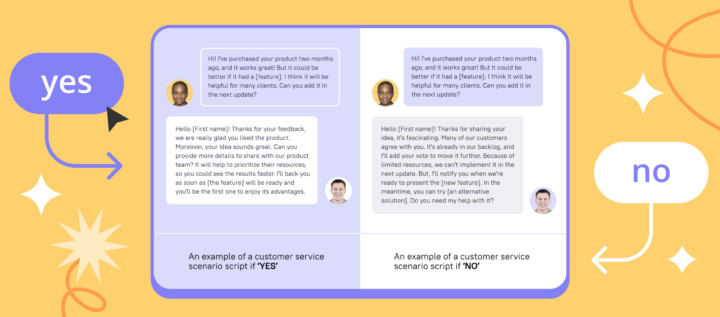Explore Support Requests Using Tag Analytics

Recently, we released the new feature — conversation tag analytics. Now it’s much easier to see what types of requests you get most often. Explore them to see how you can improve the website, enhance your product, or modify your product range.
Conversation tag analytics helps you understand why users request your support. You can see the trends of which tags agents added in particular channels during a period.
If you get a lot of similar requests and your agents don’t miss anything and tag incoming requests, you’ll be able to do a simple analysis and get valuable insights.
Read also: how to find respondents for a survey or customer interview
Let’s say you’re working in an online store. Here’s what you can do with Tag Analytics:
- increase the CR of your marketing materials when you make your emails easy to understand;
- increase sales as you build your stock of products that sell well and save on goods that don’t sell much;
- increase the conversion rate of your website as you fix bugs and resolve challenging issues;
- improve the response speed of agents as you cover frequently asked questions with saved replies or knowledge base articles.
And here’s what you can benefit from tag analytics if you have a digital product:
- save time and focus on developing more demanded tools;
- retain customers who wanted to leave you due to bugs and issues;
- improve the response speed of agents as you cover frequently asked questions with saved replies or knowledge base articles.
Conversational tags report is a part of the Team performance report and is available if you have an Automation or Premium plan. In addition to this report, you can also see their response time, workload by hours, detailed agent’s report and customer satisfaction and other metrics.
Read also: The North Star Metric and How Can This Lead to Success
Let’s consider an example to see which insights you can get exploring the monthly statistics on tags.
Let’s say you have this report for November:
You see that you mostly get questions related to orders, products, and your special offers. In November, there are Black Friday and Cyber Monday, so that’s why the number of questions related to these promos skyrocketed.
Skip through the list. What are users asking?
- Order-related questions. If users ask where their orders are, you probably should improve your notification system. Try sending transactional emails with parcel IDs for tracking.
- Black Friday, Cyber Monday, and other offers. If users find your promo terms difficult, take this into account and make it the other way next time.
- Questions related to products, delivery, returns, and loyalty program: if users ask the same things over and over again, publish saved replies to these questions.
Share your data and improvement ideas with support agents, marketers, and developers. Get back to this report in a month and see if the number of questions changed and adjust your next steps accordingly.
Read also: 10 Best Customer Service Chatbot Platforms to Level Up the Work
If you get a lot of requests and you don’t use tags yet, it’s about time to begin! Ask agents to tag essential conversations. You can divide them into:
- feature, service, or product requests;
- bug and poor service complaints;
- delivery, payment, and other issues.
Read also: Find out the best Intercom alternatives and Drift alternative
How Does Tag Analytics Work?
Tag Analytics is available via Team Performance Report. If you have an Automation or Premium plan, you’ll see the new Tags tab.
The tab shows:
- the number of tagged questions;
- share in the general question count.
You can filter tags by:
- date,
- channel,
- particular agent.
When you select the parameters you need, click “Apply filters”.
By default, a monthly conversation tags report is available. You can select any period up to 90 days.
For each tag, you can see the trend compared to the same period in the past. That is, if you look at the weekly figures, you’ll see the trends compared to one week ago.
You can export tag statistics in .CSV.
You can’t do well without quality customer support. Finally, let us treat you with some articles that’ll help you improve customer support:
- How to Speed Up Your Customer Support with Dashly Saved Replies
- How to Make the Customer Support Team More Effective
- Answer questions before users ask: create your own Knowledge base
- The key support and chat metrics that you should start measuring today
Read also:
- Customer VS Client — making the difference clear
- Why eCommerce and omnichannel are inseparable?
- How to qualify lead within sales and marketing teams
- Ultimate guide to inbound lead qualification in EdTech marketing
- How to Qualify and Collect More Leads with Lead Bot?
- How BANT sales process can help you get qualified SQL in 2022




![Top 10 Best Custom Chatbot Platforms for your website [+AI]](https://www.dashly.io/blog/wp-content/uploads/2020/06/cover-1-720x308.jpg)

